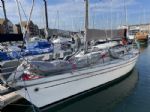












| Laser 28 - Excellent example of this great design Hamble le rice |
 |
| Rossiter Pintail Mortagne sur Gironde, near Bordeaux |
 |
List classes of boat for sale |
Rules 'For Idiots' |
Post Reply 
|
Page <123> |
| Author | ||||
gordon 
Really should get out more 
Joined: 07 Sep 04 Online Status: Offline Posts: 1037 |
 Post Options Post Options
 Quote Quote  Reply Reply
 Topic: Rules 'For Idiots' Topic: Rules 'For Idiots'Posted: 05 May 09 at 11:00am |
|||
|
Mtoogood
In the situation you set out inside boat is overlapped to windward. If you read the definition of mark room then when a boat is overlapped to windward and on the inside then mark room includes room to tack. Outside boat must give sufficient room for inside boat to tack. This raises a more general point. The Definitions are probably the most important part, and the most neglected, part of the rules. Whenever a word in a rule is in italics this refers to a definition. The definition forms part of the rule. It is worth spending a bit of time reading and making sense of what the definitions say. Gordon |
||||
|
Gordon
|
||||
 |
||||
Brass 
Really should get out more 
Joined: 24 Mar 08 Location: Australia Online Status: Offline Posts: 1151 |
 Post Options Post Options
 Quote Quote  Reply Reply
 Posted: 06 May 09 at 2:29am Posted: 06 May 09 at 2:29am |
|||
Fine so far
I can't picture this. If IW has come up to pass head to wind, from a position to windward of OL, then OL will be somewhere astern of IW. How can OL affect IW's ability to 'set sails on port tack'? But it doesn't matter. A tack is not 'complete' until the boat has borne away onto a close hauled course. When a boat passes head to wind she commences her tack (or so we would have said under the pre-1995 rules: the RRS no longer use the defined term 'tacking', and probably in the simple english usage a boat is 'tacking' all the way from close hauled on the old tack to close hauled on the new tack). Rule 18.2(c) switches off a boat's rule 18.2(b) entitlements to mark-room when either boat passes head to wind, leaving rule 18.2(a) entitlement to whoever is the inside boat intact. But at a windward mark, with two boats initially on same tack, rule 18.1(b) switches off rule 18 in its entirity when one boat passes head to wind so that 'boats [are] on opposite tacks [and] the hproper course for one, but not both is to tack.' So all mark-room entitlements disappear when IW passes head to wind.
I still don't get the geometry: if OL has kept clear during IW's big stern-swing to come up to head to wind, surely it is going to be very difficult for OL to still be hooked up overlapped outside IW's stern so as to be in the way as IW bears away? But again it doesn't matter: You are quite correct: OL is now starboard tack, owing no mark-room to IW now on port: if IW bears away and contacts OL or causes OL to change course to avoid contact with IW, then IW breaks rule 10 and probably rule 13. Tactically, I suppose IW could play it like this: Wait till she was at the mark before changing course. Change course towards the wind as fast as she likes (protected by her rule 18.5 exoneration from rule 16) so that there is risk of contact with OL, then curtail her course-change, so as to avoid contact with OL and protest OL for not giving her mark-room, all before IW passes head to wind. Absent other boats outside, OL should then bear away to get well clear and take her penalty turns, making room for IW to tack. If IW passes head to wind and makes contact, she is in dire peril: she just might claim that OL failing to give her mark-room compelled her, several seconds later once she had passed head to wind, to fail to keep clear of OL, and to contact OL, but this would be massively relying on charity from the protest committee. Bottom line is that OL may well be able to get the close hook-up and exert control from the leeward position, unless IW is very neat and tidy with her seamanship. Edited by Brass |
||||
 |
||||
gordon 
Really should get out more 
Joined: 07 Sep 04 Online Status: Offline Posts: 1037 |
 Post Options Post Options
 Quote Quote  Reply Reply
 Posted: 06 May 09 at 8:36am Posted: 06 May 09 at 8:36am |
|||
|
K.I.S.S.
A boat is tacking (in so far as rule 13 "while tacking" applies) from the time she passes head to wind until she is on a close hauled course. During this time an inside overlapped boat who is entitled to mark-room is, by the definition of mark-room, still entitled to room. This entitlement does not disappear when 18.2b switches off. If there is contact during the time that inside windward boat is subject to rule 13 then outside boat has failed to give mark room and inside boat is exonerated under 18.5a (but not from breaking rule 14 if this was an issue). Inside windward boat, however, does not have mark room to bear away below close-hauled, nor to sail her proper course at the mark whilst outside leeward boat remains on starboard. But as boats are now sailing away from each other this should not be an issue. As soon as outside leeward boat passes head to wind she must keep clear (rule 13) and, as she is now on the same tack as inside boat, must give mark room under 18.2a. Gordon |
||||
|
Gordon
|
||||
 |
||||
mtoogood 
Newbie 
Joined: 05 May 09 Location: United Kingdom Online Status: Offline Posts: 2 |
 Post Options Post Options
 Quote Quote  Reply Reply
 Posted: 06 May 09 at 7:05pm Posted: 06 May 09 at 7:05pm |
|||
|
thanks gordon - admirably simple and i am sure correct!
|
||||
|
solent scow sailor
|
||||
 |
||||
Brass 
Really should get out more 
Joined: 24 Mar 08 Location: Australia Online Status: Offline Posts: 1151 |
 Post Options Post Options
 Quote Quote  Reply Reply
 Posted: 07 May 09 at 4:09am Posted: 07 May 09 at 4:09am |
|||
|
I have to disagree with you Gordon. There is no longer any express entitlement to room to tack as part of rounding a mark. The new definition of mark-room just tells us when mark-room does not include room to tack. At a windward mark, with two boats initially on same tack, rule 18.1(b) switches off rule 18 in its entirity when one boat passes head to wind so that 'boats [are] on opposite tacks [and] the proper course for one, but not both is to tack.' So all mark-room entitlements disappear when one of the two boats passes head to wind. See Case 50, last paragraph: "If A were to pass head to wind, then at that moment all parts of rule 18 would cease to apply because the boats would be on opposite tacks (see rule 18.1(b))."
Disagree: once inside passes head to wind the whole of rule 18 is off
Agree rule 18.5 never switches rule 14 off.
Agree, rule 18 is back ON from when she passes head to wind.
Edited by Brass |
||||
 |
||||
ColPrice2002 
Far too distracted from work 
Joined: 25 Nov 08 Location: United Kingdom Online Status: Offline Posts: 222 |
 Post Options Post Options
 Quote Quote  Reply Reply
 Posted: 07 May 09 at 9:05am Posted: 07 May 09 at 9:05am |
|||
|
Consider the situation as if the mark were not there:- If IW heads up to close hauled, then OW heads up to close hauled as well, then IF IW cannot tack because the stern swing would hit OW, then OW has not given IW sufficient time or space to keep clear (Rule 16). Otherwise, IW could be put in the impossible position of a) not being able to tack because of OW and b) [possibly] sailing a lower close hauled course. It isn't possible to establish an overlap from leeward without allowing the give-way boat to keep clear (Rule 17). Colin |
||||
 |
||||
tack'ho 
Really should get out more 
Joined: 08 Feb 06 Location: United Kingdom Online Status: Offline Posts: 1100 |
 Post Options Post Options
 Quote Quote  Reply Reply
 Posted: 07 May 09 at 12:15pm Posted: 07 May 09 at 12:15pm |
|||
mmmmmm....really? |
||||
|
I might be sailing it, but it's still sh**e!
|
||||
 |
||||
ChrisJ 
Far too distracted from work 
Joined: 07 May 04 Location: United Kingdom Online Status: Offline Posts: 337 |
 Post Options Post Options
 Quote Quote  Reply Reply
 Posted: 07 May 09 at 2:40pm Posted: 07 May 09 at 2:40pm |
|||
|
Location: Australia
|
||||
 |
||||
gordon 
Really should get out more 
Joined: 07 Sep 04 Online Status: Offline Posts: 1037 |
 Post Options Post Options
 Quote Quote  Reply Reply
 Posted: 07 May 09 at 5:57pm Posted: 07 May 09 at 5:57pm |
|||
|
Brass,
To avoid confusing sailors by our arguments I suggest we do what most judges do when they have different interpretations - we adjourn to a quiet corner of the bar, discuss the matter and come back with a considered answer. I will contact you directly, and promise to return to this thread with a considered answer One point, you seem to be quoting a Case, but it is not Case 50 in my Case book - could you check the reference. Gordon |
||||
|
Gordon
|
||||
 |
||||
Brass 
Really should get out more 
Joined: 24 Mar 08 Location: Australia Online Status: Offline Posts: 1151 |
 Post Options Post Options
 Quote Quote  Reply Reply
 Posted: 08 May 09 at 12:54am Posted: 08 May 09 at 12:54am |
|||
|
I do apologise: it's Case 15, not Case 50. |
||||
 |
||||
Post Reply 
|
Page <123> |
| Forum Jump | Forum Permissions  You cannot post new topics in this forum You cannot reply to topics in this forum You cannot delete your posts in this forum You cannot edit your posts in this forum You cannot create polls in this forum You cannot vote in polls in this forum |
Copyright ©2001-2010 Web Wiz
Change your personal settings, or read our privacy policy











 Printable Version
Printable Version Delicious
Delicious Digg
Digg Facebook
Facebook Furl
Furl Google
Google MySpace
MySpace Newsvine
Newsvine reddit
reddit StumbleUpon
StumbleUpon Twitter
Twitter Windows Live
Windows Live Yahoo Bookmarks
Yahoo Bookmarks Topic Options
Topic Options